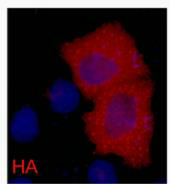HA-Tag Monoclonal Antibody(1B10)
- Catalog No.:YM3003
- Applications:WB;ELISA;IF
- Reactivity:Species independent
- Target:
- HA-Tag
- Gene Name:
- HA Tag
- Protein Name:
- HA-Tag
- Immunogen:
- Synthetic Peptide of HA-Tag
- Specificity:
- The antibody detects C-terminal, internal, and N-terminal HA-tag fusion proteins.
- Formulation:
- PBS, pH 7.4, containing 0.5%BSA, 0.02% sodium azide as Preservative and 50% Glycerol.
- Source:
- Monoclonal, Mouse
- Dilution:
- WB 1:5000 IP: 1:200 IF 1:1000;ELISA 1:5000-20000
- Purification:
- The antibody was affinity-purified from mouse ascites by affinity-chromatography using specific immunogen.
- Storage Stability:
- -15°C to -25°C/1 year(Do not lower than -25°C)
- Background:
- Human influenza hemagglutinin (HA) is a surface glycoprotein required for the infectivity of the human virus. The HA tag is derived from the HA-molecule corresponding to amino acids 98-106 has been extensively used as a general epitope tag in expression vectors. Many recombinant proteins have been engineered to express the HA tag, which does not appear to interfere with the bioactivity or the biodistribution of the recombinant protein.
Carbon Catabolite Repression Governs Diverse Physiological Processes and Development in Aspergillus nidulans | mBio Mbio. 2022 Feb;:. WB S. cerevisiae 1:2000
Mammalian CST averts replication failure by preventing G-quadruplex accumulation. NUCLEIC ACIDS RESEARCH 2019 Jun 04 IF Human HeLa cell
Upregulation of α enolase (ENO1) crotonylation in colorectal cancer and its promoting effect on cancer cell metastasis. BIOCHEMICAL AND BIOPHYSICAL RESEARCH COMMUNICATIONS Biochem Bioph Res Co. 2021 Nov;578:77 IP Human 1:5000 HCT116 cells
AtHD2D, A Plant-specific Histone Deacetylase Involved in Abscisic Acid Response and Lateral Root Development JOURNAL OF EXPERIMENTAL BOTANY Zhaofen Han CoIP Arabidopsis thaliana
Antagonistic MADS-box transcription factors SEEDSTICK and SEPALLATA3 form a transcriptional regulatory network that regulates seed oil accumulation Journal of Integrative Plant Biology Shuangcheng He CoIP,WB Arabidopsis thaliana siliques
Phosphorylation of PBK at Thr9 by CDK5 correlates with invasion of prolactinomas CNS Neuroscience & Therapeutics Qiuyue Fang WB,CoIP Human 1:5000 HEK293T cell
Interaction of Soybean (Glycine max (L.) Merr.) Class II ACBPs with MPK2 and SAPK2 Kinases: New Insights into the Regulatory Mechanisms of Plant ACBPs Plants-Basel Atieh Moradi WB Nicotiana tabacum,Yeast 1:5000 leaf
BnaC06.WIP2-BnaA09.STM transcriptional regulatory module promotes leaf lobe formation in Brassica napus INTERNATIONAL JOURNAL OF BIOLOGICAL MACROMOLECULES Shuangcheng He CoIP Brassica napus Leaf
- June 19-2018
- WESTERN IMMUNOBLOTTING PROTOCOL
- June 19-2018
- IMMUNOHISTOCHEMISTRY-PARAFFIN PROTOCOL
- June 19-2018
- IMMUNOFLUORESCENCE PROTOCOL
- September 08-2020
- FLOW-CYTOMEYRT-PROTOCOL
- May 20-2022
- Cell-Based ELISA│解您多样本WB检测之困扰
- July 13-2018
- CELL-BASED-ELISA-PROTOCOL-FOR-ACETYL-PROTEIN
- July 13-2018
- CELL-BASED-ELISA-PROTOCOL-FOR-PHOSPHO-PROTEIN
- July 13-2018
- Antibody-FAQs
- Products Images
.jpg)
- Ge, Lu, et al. "PRMT5 promotes epithelial‐mesenchymal transition via EGFR‐β‐catenin axis in pancreatic cancer cells." Journal of cellular and molecular medicine 24.2 (2020): 1969-1979.

- 0.5ug HA fusion protein+ Primary antibody dilution at 1:10000

- IF analysis of 293 cells transfected with a HA-tag protein,1:2000 dilution (blue DAPI, red anti-HA)

- IP antibody use:5ug HA Mouse IgG1 per ml Lysate,WB 1:5000 1、untransfected 293 cell lysate 2、transfected 293 cell lysate with HA-tag fusion protein 3、IP(untransfted 293+anti-HA mAb+Protein G agarose) 4、IP (transfected 293+ normal Mouse IgG+Protein G agarose) 5、IP (transfected 293+anti-HA mAb+ Protein G agarose) 6、IP (transfected 293+Protein G) 7、Recombinant protein (E.coli)



